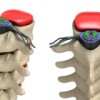The bones of the spine are separated by tough cartilage pads called intervertebral discs, literally meaning “between the bones of the spine). Healthy discs are like a wet sponge – they are thick and flexible. This allows a wide range of bending and twisting motions in the spine. An unhealthy disc is like a dry sponge – stiff and hard. This makes it prone to injuries such as bulging or herniation. Over time, the discs in the spine may compress or degenerate, due to an accumulation of trauma, untreated joint disfunction, or simply gravity. This constant compression prevents much-needed oxygen and nutrients from entering the disc, and the once-tough outer layers of the disc can soften and allow the disc to become injured or diseased. The discs of the neck (cervical spine) and low back (lumbar spine) are the most commonly injured, although these types of injuries can occur in any of the spinal discs.
A. |
B. |
C. |
| Disc Bulge (A) | Herniated Disc (B) | Disk Rupture (C) |
Significant disc damage can lead to a Disc Bulge, become a tear called a Disc Herniation or the inner gelatinous material of the disc can leak out in the case of a Ruptured Disc. The “jelly center” of the disc can also dry out over time which is referred to as Degenerative Disc Disease. All forms of disc injury can eventually impinge on the nerves exiting the spine (“pinched nerve”) which can create numbness, tingling, burning or sharp pain down the arms or legs. Sharp pain originating from the back and “shooting” down the legs is often referred to as sciatica.
The most effective treatment available to heal a Disc Bulge is Non-Surgical Spinal Disc Decompression using the DTS Spinal Decompression Machine.
Disc Bulge: Definition
A Disc Bulge occurs when the tough outer fibers of the spinal disc weaken and stretch allowing the “jelly center” of the disc to “bulge” outward. A Disc Bulge is generally considered the first step toward a more serious problem called a Herniated Disc. A Herniated Disc is similar to a Disc Bulge except that the outer layers of the disc actually weaken to the point of tearing.
Herniated Disc: Definition
A Herniated Disc occurs when the tough outer fibers of the spinal disc tear, thus allowing the “jelly center” of the disc to herniate or bulge outward. A Herniated Disc is generally considered to be more serious than a Disc Bulge where the outer wall of the disc is weakened but not torn.
Disc Bulge / Disc Herniation: Symptoms
The majority of symptoms caused by a Disc Bulge or Herniated Disc are related to irritation of spinal nerves. These nerves exit the spine through small holes called foramen. The spinal discs are located next to these nerve passageways, and the bulging of the disc material can “pinch” these nerves, thereby creating a variety of uncomfortable and sometimes debilitating symptoms.
 |
 |
Disc Bulge / Herniated Disc of the Low Back:
Lumbar Spine Disc Bulge
A Disc Bulge in the low back can cause low back pain or numbness, tingling, burning, sharp pain or weakness in the legs or feet. Sharp pain along the back of the legs is often referred to as sciatica.
Disc Bulge / Herniated Disc of the Neck:
Cervical Spine Disc Bulge
A Disc Bulge in the neck can cause neck pain, or in more severe cases, numbness, tingling, burning, sharp pain or weakness in the arms or hands.
Treatment Using The DTS
Spinal Decompression Therapy System
DTS Spinal Decompression Therapy is a non-surgical, state-of-the-art treatment which provides relief to severe back and neck pain. The bones of the spine are slowly and gently separated. As the vertebrae are separated, pressure within the disc (intradiscal pressure) is reduced to the point where a vacuum is formed. This vacuum “sucks” the gelatinous center of the disc back into the disc thereby reducing the Disc Bulge. This takes pressure off the spinal nerves and drastically reduces pain. This action also allows much-needed oxygen and nutrients to flow into the injured discs to aid in the healing process.


